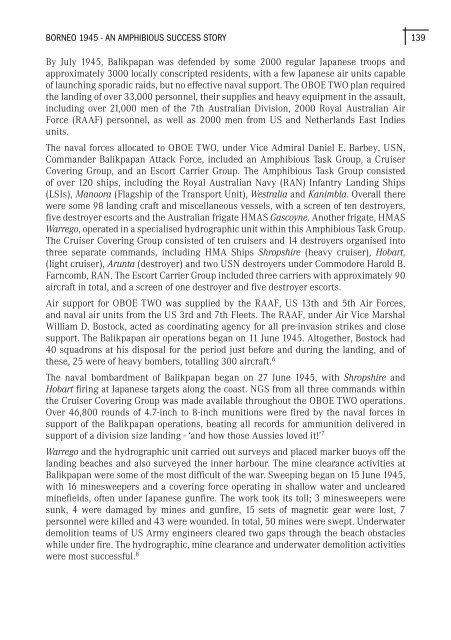Australian Maritime Issues 2005 - Royal Australian Navy
Australian Maritime Issues 2005 - Royal Australian Navy
Australian Maritime Issues 2005 - Royal Australian Navy
You also want an ePaper? Increase the reach of your titles
YUMPU automatically turns print PDFs into web optimized ePapers that Google loves.
BORNEO 1945 - AN AMPHIBIOUS SUCCESS STORY<br />
139<br />
By July 1945, Balikpapan was defended by some 2000 regular Japanese troops and<br />
approximately 3000 locally conscripted residents, with a few Japanese air units capable<br />
of launching sporadic raids, but no effective naval support. The OBOE TWO plan required<br />
the landing of over 33,000 personnel, their supplies and heavy equipment in the assault,<br />
including over 21,000 men of the 7th <strong>Australian</strong> Division, 2000 <strong>Royal</strong> <strong>Australian</strong> Air<br />
Force (RAAF) personnel, as well as 2000 men from US and Netherlands East Indies<br />
units.<br />
The naval forces allocated to OBOE TWO, under Vice Admiral Daniel E. Barbey, USN,<br />
Commander Balikpapan Attack Force, included an Amphibious Task Group, a Cruiser<br />
Covering Group, and an Escort Carrier Group. The Amphibious Task Group consisted<br />
of over 120 ships, including the <strong>Royal</strong> <strong>Australian</strong> <strong>Navy</strong> (RAN) Infantry Landing Ships<br />
(LSIs), Manoora (Flagship of the Transport Unit), Westralia and Kanimbla. Overall there<br />
were some 98 landing craft and miscellaneous vessels, with a screen of ten destroyers,<br />
five destroyer escorts and the <strong>Australian</strong> frigate HMAS Gascoyne. Another frigate, HMAS<br />
Warrego, operated in a specialised hydrographic unit within this Amphibious Task Group.<br />
The Cruiser Covering Group consisted of ten cruisers and 14 destroyers organised into<br />
three separate commands, including HMA Ships Shropshire (heavy cruiser), Hobart,<br />
(light cruiser), Arunta (destroyer) and two USN destroyers under Commodore Harold B.<br />
Farncomb, RAN. The Escort Carrier Group included three carriers with approximately 90<br />
aircraft in total, and a screen of one destroyer and five destroyer escorts.<br />
Air support for OBOE TWO was supplied by the RAAF, US 13th and 5th Air Forces,<br />
and naval air units from the US 3rd and 7th Fleets. The RAAF, under Air Vice Marshal<br />
William D. Bostock, acted as coordinating agency for all pre-invasion strikes and close<br />
support. The Balikpapan air operations began on 11 June 1945. Altogether, Bostock had<br />
40 squadrons at his disposal for the period just before and during the landing, and of<br />
these, 25 were of heavy bombers, totalling 300 aircraft. 6<br />
The naval bombardment of Balikpapan began on 27 June 1945, with Shropshire and<br />
Hobart firing at Japanese targets along the coast. NGS from all three commands within<br />
the Cruiser Covering Group was made available throughout the OBOE TWO operations.<br />
Over 46,800 rounds of 4.7-inch to 8-inch munitions were fired by the naval forces in<br />
support of the Balikpapan operations, beating all records for ammunition delivered in<br />
support of a division size landing - ‘and how those Aussies loved it!’ 7<br />
Warrego and the hydrographic unit carried out surveys and placed marker buoys off the<br />
landing beaches and also surveyed the inner harbour. The mine clearance activities at<br />
Balikpapan were some of the most difficult of the war. Sweeping began on 15 June 1945,<br />
with 16 minesweepers and a covering force operating in shallow water and uncleared<br />
minefields, often under Japanese gunfire. The work took its toll; 3 minesweepers were<br />
sunk, 4 were damaged by mines and gunfire, 15 sets of magnetic gear were lost, 7<br />
personnel were killed and 43 were wounded. In total, 50 mines were swept. Underwater<br />
demolition teams of US Army engineers cleared two gaps through the beach obstacles<br />
while under fire. The hydrographic, mine clearance and underwater demolition activities<br />
were most successful. 8

















